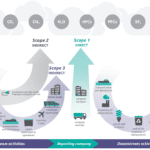As regulations across the globe strengthen, the pressure to collect, report, and organize emission-related metrics has never been higher. This added responsibility for companies will have lasting effects on business operations, corporate partnerships, supply chain logistics, compliance requirements, and data integrity.
Structure Your Data for Seamless Reporting
Most reporting statutes already require or will require companies to provide data for their Scope 1 through 3 emissions. Regulations requiring Scope 3 emissions data from companies, create an end-to-end value chain reporting issue. This will urge companies to verify their emissions upstream, internally, and downstream to meet regulatory needs and the increased demands for verifiable data for their downstream customers. Understanding the scopes is essential for structuring your data. The Corporate Sustainability Directive will also require companies to report on materiality conceptual guidelines, double materiality, impact materiality, and financial materiality.
Between the Carbon Border Adjustment Mechanism (CBAM) and the Corporate Sustainability Reporting Directive (CSRD), any large company that intends to conduct business in the European Union will be responsible for reporting on data that encapsulates environmental risk, procurement statistics, and supply chain impacts. For example, once the permanent CBAM system enters into force on 1 January 2026, importers will need to declare annually the number of goods imported into the EU in the preceding year and their embedded GHG emissions.
Across the globe, requirements for stricter reporting on complex metrics are increasing. This additional pressure for sustainability data will impact business operations, employee responsibilities, candidate recruitment, and company performance measures. The shift in priorities will ripple across companies and include additional personnel who may have been previously left out.
As regulations strengthen, an increased focus on data architecture will be essential so that continued reporting will eventually become seamless. To provide a complete picture of sustainability reporting, data from a large variety of disparate systems must be consolidated into a single environment. It’s important to stay cognizant of regulations and the impact they will have on your company so that you can be prepared and equipped with the tools to stay compliant.
In 2021, 99 percent of S&P 500 companies reported ESG-related information. Without a single standardized reporting framework, voluntary frameworks are available and provide companies with a structure in which they can organize their various data sets. Most companies are adopting frameworks and standards, including:
Sustainability Accounting Standards Board (SASB)
Global Reporting Initiative (GRI)
International Sustainability Standards Board (ISSB)
Integrated Reporting Framework
Together, these frameworks provide a glimpse of what will be expected of companies by regulatory entities in the coming future. Reporting frameworks are obsolete without the data that goes into them. What good does a reporting framework provide if the data input is faulty, old, and unverified? Multiple steps must be taken to produce a baseline data architecture suitable for reporting data related to sustainability, environmental, and financial impacts.
Creating a Data Architecture That Is Meant to Be Built Upon and Grown Annually
Ever heard of that saying, “leave it the way you found it?” Do your future self a favor and create a database that is legible, accessible, and accurate, so that when it’s time to report again a year later you have baseline data to work from. Developing a data architecture meant for annual use will save time and effort for sustainability teams responsible for organizing past data. If the resources and software are applicable, automate as much of your data collection as possible. Reducing the amount of human intervention will reduce operator error which can increase the data’s integrity.
Look Wider: Sources of Data Can Be Found Across the Entire Organization
Data for sustainability reporting comes from many different parts of the organization, including manufacturing operations, EHS, HR, supply chain, and procurement. A best practice is not to leave out information on environmental reporting included in a company’s financial reporting process. Finding this data may reveal that double the work is being completed to source information that already exists in other branches. Identifying these inefficiencies will save time, effort, and money.
The post Stringent Reporting Regulations Require Data Integrity appeared first on Logistics Viewpoints.
